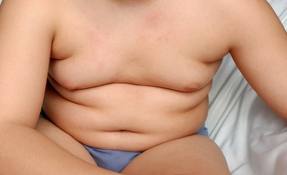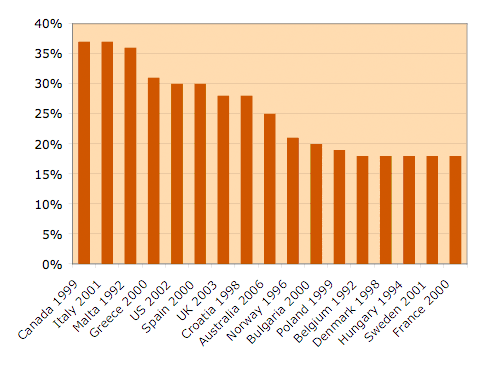Food marketing undermines the efforts of parents, teachers and doctors to teach children about healthy eating. The onslaught of advertisements for fast foods, sugary foods and salty foods encourage children to favour such foods over more healthy and natural alternatives, such as fruit and vegetables. The US Department of Agriculture claims that children get  an appetite for high levels of sugar and salt in their food and drinks before they even go to school.
an appetite for high levels of sugar and salt in their food and drinks before they even go to school.
The link between advertising and diet which is documented in a number of studies, has also been confirmed using experiments. In one, children shown advertisements for snack food choose candy bars and jelly beans to snack on significantly more than children shown public service announcements about good nutrition, who tended to choose raisins, peanuts and fruit.
In another experiment, children attending summer camp were shown commercials for sugary foods and Kool Aid or advertisements for orange juice and fruit or public service announcements about the need to moderate sugar intake or no advertisements during their voluntary television watching. All the children, including those who had seen no advertisements, tended to eat fruit and orange juice rather than Kool Aid and candy except those who had seen the advertisements for these things.
Television advertisements are only one avenue that marketers use to communicate with children and the effectiveness of junk food marketing on the internet, video games and other media has seldom been studied. “Marketing is one of the least understood aspects of the new digital media culture.”
 Today’s children snack more and get a much higher proportion of their daily food from snacks and sweetened drinks. In the US the Institute of Medicine has found that children are consuming excess calories, sugar, salt and fats and inadequate levels of whole grains, fiber, calcium, iron, potassium, and magnesium, which is putting their health at risk.
Today’s children snack more and get a much higher proportion of their daily food from snacks and sweetened drinks. In the US the Institute of Medicine has found that children are consuming excess calories, sugar, salt and fats and inadequate levels of whole grains, fiber, calcium, iron, potassium, and magnesium, which is putting their health at risk.
Ofcom found that foods promoted to children in the UK are predominantly those that are high in fats and sugars and salts, and that the foods also predominate their diets to the extent that they eat far less than the recommended amounts of fresh fruit and vegetables. It also found that the consumption of fresh green vegetables has declined since 1975.
The Ofcom review also found that obese children eat more frozen food, microwaved food, carbonated drinks, snacked more on crisps and nuts than other children and ate less home-made food and fewer vegetables and fruits. Similarly a National Diet and Nutrition Survey in the UK in 2000 found that most children eat too much saturated fat, sugar and salt and 96 percent do not eat enough fruit and vegetables.
Between 1985 and 1995 childhood consumption of sugary food rose in Australia, particularly sweets and drinks other than water. Most children’s cereals, for example, contain too much sugar and salt and not enough fibre, according to a survey by Choice magazine. They “gave children a short-term sugar hit but left them lacking in energy later in the day”.
 A study by University of Sydney researcher, Karen Webb, found that toddlers (16-24 months) were getting a quarter of their food from chips, cordial and soft drinks, cakes and biscuits and other nutritionally poor snacks. This means that not only are they getting less of the healthy food they need, but that they are acquiring food preferences that will serve them poorly in the future. Older children (8-11) get about a third of their daily calories from junk food.
A study by University of Sydney researcher, Karen Webb, found that toddlers (16-24 months) were getting a quarter of their food from chips, cordial and soft drinks, cakes and biscuits and other nutritionally poor snacks. This means that not only are they getting less of the healthy food they need, but that they are acquiring food preferences that will serve them poorly in the future. Older children (8-11) get about a third of their daily calories from junk food.
Worldwide children are consuming excess calories, sugar, salt and fats and inadequate levels of whole grains, fruit and vegetables, fibre, calcium, iron, potassium, and magnesium, which is putting their health at risk.
The World Health Organisation (WHO) claims that obesity is a global epidemic. During the 1980s and 1990s children’s obesity rates rose dramatically in many nations as have adult rates. “At least 20 million children under the age of 5 years are overweight globally in 2005.”
Percentage of Overweight Children Around 10 Years Old

The rates for Australian children aged 7 to 15 more than tripled between 1985 and 1995 from just over 1 percent to 5.5 percent for girls and 4.7 percent for boys. Today 1 in 12 Australian children (over 8 percent) is obese and around one in 4 is overweight despite their doing as much exercise as ever.
Percentage of Overweight Children in Australia aged 7-11 years

In the UK obesity and overweight has also been increasing. In 2003 28 percent of children aged between 2 and 10 were overweight and half of these, 14 percent were obese and the rate has been rising rapidly over the past ten years. An astounding 45 percent of girls between 11 and 15 are overweight or obese. Sir John Krebs, chair of the UK Food Standards Agency has warned that today’s children will have a shorter life expectancy than their parents because of obesity; the first time that life expectancy has declined in the UK in over a century.
According to the Centers for Disease Control and Prevention (CDC) in the US, the percentage of children between 6 and 11 years old who are overweight tripled between 1980 and 2004. Eighteen percent of children are now obese compared with less than five percent in the early 1970s with a similar number at risk of obesity (see diagram below). 300,000 people died in the US in 2000 from obesity related causes so that obesity is approaching tobacco as the leading cause of preventable death.
In Canada, 37 percent of children ages between 2 and 11 were overweight and 18 percent obese in 1999. It is expected that if present trends continue almost half of the children living in both North and South America will be overweight within four years.
Obesity in US Children Aged 6 to 11 Years

Overweight children are more likely to suffer from high blood pressure, clogged arteries, “hypertension, type 2 diabetes, respiratory ailments, orthopedic problems, trouble sleeping, and depression”, as well as heart disease, stroke, circulatory problems, infertility, breast cancer and other problems later in life.
In the US “The prevalence of type 2 diabetes among children and youth – previously known as “adult-onset” diabetes – has more than doubled in the past decade.” Sixty percent of children between 5 and 10 who are overweight have evidence of heightened cardiovascular risk such as elevated blood pressure. They are also very likely to become obese when they are older and suffer even worse health problems.
In Europe, where it is expected a third of children will be overweight within four years, the International Association for the Study of Obesity (IASO) claims “Over-eating has resulted in 20,000 children suffering from so called ‘adult onset’ or Type 2 diabetes, not previously seen in children, while over 400,000 have impaired glucose tolerance, a pre-diabetic stage which puts them at sharply increased risk of the condition… Over one million children in Europe are estimated to have high blood pressure or high cholesterol levels, putting them at risk of heart disease, and 1.4 million may have early stages of liver disorder”.